Ensuring the Future of New Mexico’s Agricultural Economy

Study by UNM’s Shraddha Kunwar highlights the problems that young farmers in New Mexico face today, and some potential solutions.
The smell of green chiles roasting in the autumn and the earthy taste of blue corn are icons of New Mexico’s unique culture. Agriculture has always been a central element of New Mexico’s identity, as well as the local economy that supports it. Agriculture and food processing together accounted for $10.6 billion profit in 2012, roughly 12.3% of the state’s $86.5 billion gross product. According to a recent study on the industry by Shraddha Kunwar, a Rudolfo Anaya Graduate Fellow at the Anderson School of Management at the University of New Mexico, “These [two] industries directly created 32,578 jobs and 18,308 jobs in related support activities for a total of 50,886 jobs statewide.”
With these statistics in mind, the future of agriculture is doubtless a cornerstone to the future of the general economy in New Mexico—and especially in Albuquerque, where the South Valley supports a majority of those agricultural jobs. Kunwar’s study, which she completed with the help of the Albuquerque Community Foundation, highlights some of the obstacles that farmers and ranchers in New Mexico face today, as well as some potential solutions to those obstacles.
One of the biggest hurdles is an aging agricultural workforce. Nationwide, the population of ranchers and farmers is aging towards retirement, and relatively few young people are entering the industry to fill the gap. This declining interest in agricultural work among the younger generation is largely due to the specific economic hardships they face—namely, the capital required to buy or rent land for farming. “New Mexico farmers earn less than $35,000 annually,” Kunwar says in her study, and “many consistently incur a net loss from agricultural activities and thus depend on off-farm income to cover living expenses.” These numbers, paired with the student loan debt saddling many young people, create serious barriers to entry.
But if enough young people don’t step into the agricultural jobs that the older generation is leaving behind, the consequences could be dire: “The USDA estimates the nation will need 100,000 new producers over the next decade. If that goal is not reached, the industry will become even more consolidated and our food supply will be more reliant on imports.” A frightening possibility, especially in light of recent uncertainties around international trade.
But Kunwar suggests that there are many potential solutions to prevent this apocalyptic-sounding scenario before it starts—mainly, by empowering young farmers and would-be farmers with the resources they need to pursue agricultural work. “Capital is the most important thing,” Kunwar says, “This problem can be solved by offering tax credits to landowners who would be willing to lease or sell the land to beginning farmers. This has already happened in states like Nebraska and Iowa. Such a program should be initiated in New Mexico to encourage property owners to lease their land to beginning farmers.”
Recent legislation on federal and state levels may be helpful in encouraging young people to work in agriculture, Kunwar’s study suggests, including the adoption of the New Mexico Agriculture Workforce Development Program. This bill, which was passed in March 2019, reimburses farmers who employ interns for up to 50 percent of the employment costs (including wages and any overhead costs incurred). The program promotes paid internships, which can support the skill development needed for young people to be successful in agriculture in the future. “Some of these young farmers are first generation; nobody in their family farms,” says Kunwar. “So connecting them with an experienced farmer for an internship can be such a valuable asset.”
In her study, Kunwar also recommends increasing funding and support for some already crucial farmer training programs. The Beginning Farmer and Rancher Development Program, part of the 2008 Farm Bill, provides competitive grants to nonprofits and universities across the country to develop beginning farmer training opportunities. There’s also the Conservation Stewardship Program, which provides financial and technical assistance to farmers for improving and maintaining conservation systems, such as implementing a no-till strategy to reduce erosion.
Besides these institutional changes, though, Kunwar says that a crucial element of supporting local agriculture lies in the hands of the community. “Support young farmers by shopping with them at [the] farmers’ market: If local farmers don’t have one, consider working with farmers to start one,” her study says. Also consider writing to your representative in favor of policies that will help New Mexico farmers, like improving funding for agriculture education programs such as Future Farmers of America and 4-H.
We can’t take for granted the future of our state’s agriculture, and young people are the key to keeping that future healthy. If we invest in those young people as Kunwar suggests, we could see a surge in the number of farmers committed to healing the climate and sustaining the local economy in the process.
Connect the Dots
One of City Alive’s key focus areas is capital access. Through our Leadership Partners like Nusenda Credit Union and Southwest Capital Bank, City Alive is looking at alternative financing to support homegrown businesses. The Co-op Capital program, which originated from a pilot with La Montañita Co-op to support their food producers, now engages other community organizations in the food industry including Three Sisters Kitchen and Street Food Institute, supporting our local food economy.





